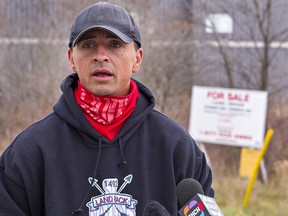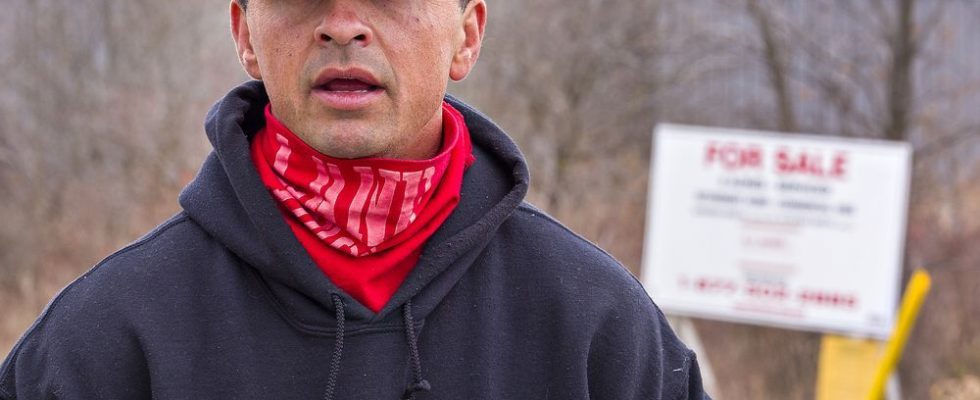
Nearly three years after he first walked onto a Caledonia construction site and became the public face of an Indigenous land defense movement known as 1492 Land Back Lane, Skyler Williams is a free man.
Williams, who is Mohawk from Six Nations of the Grand River, had pleaded guilty to three criminal charges connected to his role in stopping the construction of a planned 218-home subdivision on McKenzie Road. The parcel was 40 acres that land defenders, backed by the traditional leadership on Six Nations, say is unceded Haudenosaunee territory.
Williams’ lawyer, Joshua Frost, sought a conditional discharge for one count of mischief and two counts of failure to comply with an undertaking, while the Crown asked Justice Gethin Edward to hand down a suspended sentence, which comes with a criminal conviction.
Instead, after hearing from several expert witnesses who put Williams’ actions in their historical and legal context, Edward granted Williams an absolute discharge, meaning he left the Cayuga courthouse with no criminal conviction and no restrictions on visiting the Land Back site.
Another land defender, Deryl Porter, also received an absolute discharge.
All other charges Williams had faced, including a count of intimidation, had been with drawn prior to the sentencing hearing.
Edward said he attempted to “fashion a sentence that incorporates Haudenosaunee legal traditions,” basing his ruling on the Two Row Wampum, an agreement between the Haudenosaunee and the Dutch in upstate New York in 1613 that established a nation-to-nation relationship between Indigenous people and European settlers.
“Skyler Williams was carrying out his actions as a land protector in the context of these Haudenosaunee laws,” Edward said, adding he granted an absolute discharge to avoid setting Williams up for future prosecution.
“Mr. Williams clearly expressed his view (that) any further attempts to develop contested lands would be revisited by him,” Edward said.
“Therefore, conditions would simply set him up for a breach.”
Reached by The Spectator after the verdict, Williams said he was pleased to put his own legal situation behind him but remained frustrated at the lack of action from Ottawa and Queen’s Park to resolve the ongoing land dispute.
“At the same time that I feel relief, I also feel anger that after all of this talk about reconciliation, all of this ‘happy Indian’ rhetoric that we keep hearing from the federal and provincial governments, when it actually comes down to it, there is no interest in giving land back to Indigenous people,” Williams said.
“There is no interest in making true reparations.”
In making his decision, Edward drew on the testimony of Indigenous scholar Rick Monture of McMaster University, who guided the judge through the history of the Haldimand Tract, an area of roughly one million acres along the full length of the Grand River granted to the Haudenosaunee by the British in gratitude for their allyship during the American Revolution.
Over time, Edward said, the Haudenosaunee were “swindled” out of this land and associated money by settlers “with absolutely no appetite to give land back to Native people.”
Referring to the Caledonia site, Edward said, “This dispute stems from the absence of any documentation that proves that there was an actual surrender by the Six Nations of this tract of land.”
This interpretation differs from that proffered in civil court by lawyers for Foxgate Developments, the consortium that has since abandoned plans to build on the McKenzie Road site.
In granting injunctions to the developers, two civil court judges agreed Foxgate has legal title to the land and the police have the right to remove the land defenders, who in the court’s eyes are trespassing. But the OPP has not made any move to enforce the permanent injunction granted last December, and most land defenders and supporters have had their charges dropped.
In her expert testimony before Edward, Indigenous lawyer Beverly Jacobs said land defenders have a recognized role in Haudenosaunee law.
“You call them protesters, we call them protectors of land and territories … for our people and for the future for our children,” Jacobs said.
Land defense is needed, Williams told The Spectator, because politicians are more interested in photo-ops than addressing historical injustices.
“Posing for the picture with the politician isn’t getting us anything or anywhere,” Williams said. “Dealing with land claims in a real way needs to be that step forward toward reconciliation.”
That process can be “uncomfortable” for Canadians, Monture said, but it is essential to address the “injustice” of having the large swath of territory given to the Haudenosaunee reduced over time to the current Six Nations reserve.
The disputed Caledonia site has been under continuous occupation since July 2020, save for a few hours on Aug. 5 when the OPP moved in and arrested Williams and others.
Today the land is dotted with tiny homes, several community buildings, a community garden and a fruit tree orchard.
Six Nations members still live at 1492 Land Back Lane with no plans to leave, even as the threat of police action still hangs over the camp, Williams said.
He noted colonial governments will often say returning land to First Nations is impossible “due to the passage of time.”
“Time has passed, and our people have been on the land. We ain’t going anywhere,” he said.
“So the passage of time says that’s our land and it’s always going to be our land.”
JP Antonacci is a Local Journalism Initiative Reporter based at the Hamilton Spectator. The initiative is funded by the Government of Canada.

Comments
Postmedia is committed to maintaining a lively but civil forum for discussion and encourages all readers to share their views on our articles. Comments may take up to an hour for moderation before appearing on the site. We ask you to keep your comments relevant and respectful. We have enabled email notifications—you will now receive an email if you receive a reply to your comment, there is an update to a comment thread you follow or if a user you follow comments. Visit our Community Guidelines for more information and details on how to adjust your email settings.
Join the Conversation